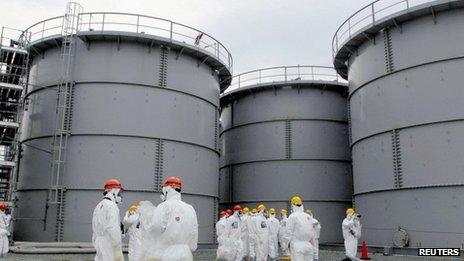Japan extends the Fukushima clean-up deadline to 2017
- Published

The plant was badly damaged by the earthquake and tsunami of March 2011
Plans to decontaminate six towns and villages close to Japan's Fukushima nuclear plant have to be delayed by up to three more years, officials say.
The clean-up of the exclusion zone around the crippled plant was initially due to be completed by next March.
More than 90,000 people remain unable to return home.
Fukushima has been hit by a series of toxic water leaks in recent months. The latest contamination was reported on Sunday after unexpectedly heavy rain.
Water with high levels of the toxic isotope Strontium-90 overflowed containment barriers around water tanks, operator Tepco said.
The tanks are being used to store contaminated cooling water from reactors damaged by the earthquake and tsunami of March 2011.
Cooling systems for reactors were knocked out, causing meltdowns at three of them.
On Monday Japan's environment ministry acknowledged the decontamination of towns around the plant is proving much more complicated than originally thought.
Tens of thousands of workers are engaged in the massive clean-up effort, removing millions of tonnes of topsoil and vegetation. But in the most highly contaminated areas work is yet to begin.
The government's latest prediction is that residents will be able to return home by 2017.
But the BBC's Rupert Wingfield-Hayes in Tokyo says many have already decided they will never go back.
Storms forecast
Ministry officials cited several reasons for the delay, including a lack of space for the waste from the decontamination work.
Water is being pumped in to cool the reactors. However, this creates large amounts of contaminated water that must be stored securely.
Some of the water has leaked from the tanks, pipes and damaged structures, leading to concerns that contaminated water is mixing with groundwater flowing into the sea.
On Sunday, the rainwater run-off - which becomes contaminated when it hits polluted surfaces areas - overflowed concrete barriers surrounding a group of tanks, reports citing the Tokyo Electric Power Company (Tepco) say.
Tepco says that in one area, readings of Strontium-90 were at 70 times the legal limit for safe disposal.
"Our pumps could not keep up with the rainwater. As a result, it flowed over some containment areas," Tepco spokesman, Yoshikazu Nagai, told Reuters news agency.
The company was quoted by Kyodo news agency as saying that some of the toxic water had seeped into the ground, but that it was unlikely to have flowed into the sea.
Strontium-90 is a radioactive by-product of the fission of uranium and plutonium inside a nuclear reactor. It is easily absorbed by the human body and is thought to be a cause of bone cancer.
More rains are expected in Japan, with meteorologists forecasting a typhoon to make landfall this week.
- Published9 October 2013
- Published3 October 2013
- Published1 October 2013
- Published1 October 2013
- Published4 September 2013
- Published1 September 2013